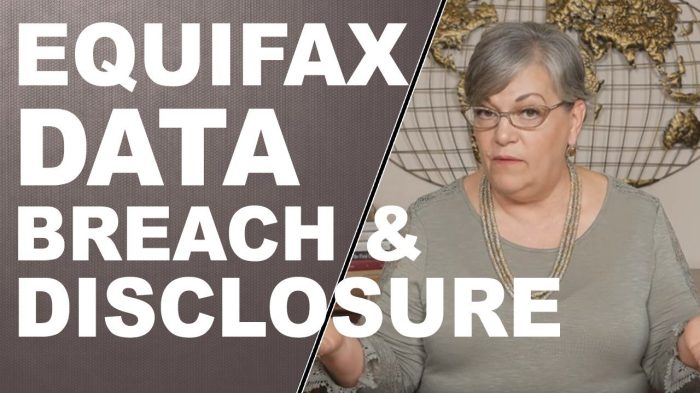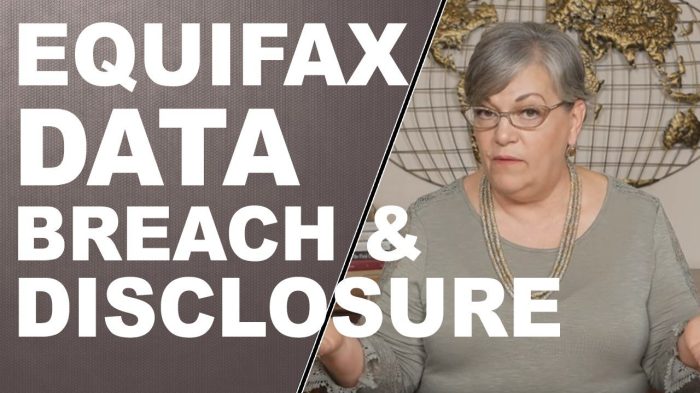Equifax insider trading data breach charges are shaking up the financial world. This massive breach, impacting millions, now faces scrutiny for potential insider trading. We’ll explore the history of the Equifax breach, the allegations of insider trading, the legal proceedings, and the wider impact on the financial market. We’ll also look at the regulatory responses, ethical considerations, and potential future implications.
The initial Equifax data breach exposed sensitive personal information, triggering a wave of public concern and financial repercussions. Now, the focus has shifted to the possibility of insider trading. The details of these allegations, the investigative processes, and potential consequences for individuals and Equifax will be examined.
Background of the Equifax Data Breach
The Equifax data breach, one of the largest and most impactful data breaches in history, exposed sensitive personal information of millions of consumers. It highlighted the vulnerabilities in large organizations and the devastating consequences of inadequate cybersecurity measures. This event significantly altered the landscape of data security and consumer trust.The breach involved unauthorized access to the personal information of approximately 147 million individuals across the United States, Canada, and Mexico.
Equifax, a major credit reporting agency, had a system flaw that allowed hackers to gain access to sensitive data, including names, Social Security numbers, birth dates, addresses, and driver’s license information.
Timeline of the Equifax Data Breach
The breach began in mid-May 2017, and the compromised data was not discovered and disclosed to the public until September 2017. This extended period of exploitation highlights the difficulty of detecting and responding to sophisticated cyberattacks.
Types of Data Compromised
The breach compromised a wide array of personal information, significantly impacting the lives of many individuals. This included:
- Names:
- Social Security Numbers:
- Birth dates:
- Addresses:
- Driver’s license information:
- Credit card information (in some cases):
The extent of the data compromised demonstrates the breadth of personal information that can be vulnerable in a large-scale breach.
Initial Public Response and Reactions
The public response to the Equifax breach was swift and overwhelmingly negative. Consumers expressed anger and distrust towards Equifax and the broader financial industry.
- Consumer outrage and distrust:
- Government investigations and scrutiny:
- Media attention and coverage:
- Class-action lawsuits:
The intensity of the public response underscored the importance of data security and the need for accountability in the face of such breaches.
Impact on Equifax’s Reputation and Financial Standing
The breach had a profound and lasting impact on Equifax’s reputation and financial standing.
- Loss of consumer trust:
- Significant decline in stock price:
- Increased regulatory scrutiny and fines:
- Legal and financial repercussions:
The incident resulted in substantial financial losses and reputational damage, serving as a stark reminder of the severe consequences of failing to prioritize cybersecurity. Equifax had to invest heavily in improving its security infrastructure and rebuilding consumer trust.
Insider Trading Allegations
The Equifax data breach, a catastrophic event exposing sensitive personal information of millions, ignited suspicion of potential insider trading activities. While the precise nature of any such illicit behavior remains under investigation, the potential for financial gain by those with privileged access to early information is undeniable. The subsequent scrutiny of trading patterns and employee activities highlights the critical need for robust regulatory frameworks to prevent and detect such offenses.The allegations surrounding insider trading in the Equifax breach center on the possibility that individuals with knowledge of the impending or ongoing breach used that information to profit from stock trades.
This exploitation of non-public information, if proven, carries significant legal ramifications and underscores the importance of maintaining ethical standards within the corporate landscape.
Specific Allegations
The specific allegations of insider trading related to the Equifax breach are multifaceted. These include accusations of employees or connected individuals using knowledge of the breach’s severity and potential scope to make preemptive or timely stock sales, while others might have avoided purchasing stocks. This illicit activity hinges on the crucial distinction between publicly available information and confidential details.
The investigation aims to determine whether specific individuals acted upon non-public knowledge, enabling them to profit from the ensuing stock market reaction to the breach.
The Equifax insider trading data breach charges are a serious issue, highlighting the vulnerabilities in corporate systems. Knowing how to properly secure your data is crucial, and if you’re looking for a way to document a specific issue, learning how to take a screenshot on your LG G4 can be incredibly helpful. For step-by-step instructions on how to take a screenshot on an LG G4, check out this helpful guide: how to take screenshot lgg4.
Ultimately, these data breaches underscore the importance of vigilance and proactive security measures in the digital age, especially when dealing with sensitive financial information.
Theories of Insider Trading
Various theories underpin the potential insider trading allegations. One theory focuses on the insider knowledge of impending negative publicity. A second theory centers on early access to data related to the scale of the breach, enabling traders to time their actions based on anticipated market impact. A third theory explores the possibility of a deliberate leak of information to facilitate insider trading.
Each theory requires meticulous examination of trading patterns, employee activities, and communication logs to determine whether any specific individual or group acted on privileged information.
Potential Individuals and Groups Involved
Identifying the specific individuals or groups potentially involved in the alleged insider trading is a complex task. Potential candidates include employees with direct access to the breach information, including IT personnel, security analysts, or those involved in data handling. Also, close associates of these individuals or entities with access to sensitive information could also be investigated. Further, any third parties with whom Equifax shared data or interacted with during the breach response could potentially be implicated.
The Equifax insider trading data breach charges are a serious issue, highlighting the vulnerability of sensitive financial data. Thinking about upgrading your phone? You could potentially save a significant amount of money on a Pixel 6 or Pixel 6 Pro by trading in your old phone, as outlined in this helpful guide: save 700 pixel 6 or pixel 6 pro trading your old phone.
Ultimately, these kinds of data breaches underscore the importance of vigilance and secure practices when handling personal and financial information.
Legal and Regulatory Frameworks
The legal and regulatory framework for insider trading is well-established, aiming to maintain market fairness and transparency. Federal securities laws, like the Securities Exchange Act of 1934, prohibit trading on non-public information. These regulations are designed to ensure that all investors have equal access to information, preventing individuals from gaining an unfair advantage. The Securities and Exchange Commission (SEC) has significant powers to investigate, prosecute, and penalize individuals engaged in insider trading.
Penalties can range from substantial fines to imprisonment. The framework relies on stringent regulations, meticulous investigations, and strong enforcement mechanisms to deter such illicit activity. These laws are intended to ensure fair play in the stock market and prevent the abuse of privileged information.
The Equifax insider trading data breach charges are a serious issue, highlighting the vulnerability of sensitive information. Meanwhile, senators are trying to add internet subsidies to the FAA reauthorization bill, which raises interesting questions about the government’s role in internet access. Ultimately, these separate but connected events underscore the need for better data security and regulatory oversight in the digital age, particularly for companies like Equifax.
Data Breach Charges and Legal Proceedings
The Equifax data breach, a catastrophic event exposing sensitive personal information of millions, also sparked allegations of insider trading. This involved individuals potentially profiting from advance knowledge of the breach before it became public. This section delves into the charges leveled against those implicated, the investigative procedures, legal actions, and potential consequences.The legal battle surrounding the Equifax breach is complex, spanning various jurisdictions and involving numerous individuals and entities.
The investigation focused on identifying those who may have traded on the non-public information of the impending data breach. The aim was to ensure accountability for such actions and protect investors.
Charges Against Individuals/Entities
The charges against individuals and entities related to insider trading in the Equifax case typically involve securities fraud. This entails allegations of using confidential, non-public information to profit from stock transactions. Specific charges often include violations of securities laws, such as Section 10(b) of the Securities Exchange Act of 1934 and Rule 10b-5. The specific charges vary depending on the individual or entity involved and the nature of the alleged trading activity.
Investigative Process
Uncovering insider trading often relies on a multifaceted investigative process. This involves meticulous analysis of financial records, trading patterns, and communications. Regulatory bodies, such as the Securities and Exchange Commission (SEC), employ advanced techniques, including market surveillance, to identify suspicious trading activities. The investigation typically scrutinizes the timing and nature of trades in relation to the public disclosure of the Equifax breach.
Tipsters and whistle-blowers may provide crucial information during this process. Analysts will evaluate if the trades were made in a way that exploited information not available to the general public.
Legal Procedures and Court Actions
Legal proceedings in insider trading cases usually involve several steps. This starts with the SEC initiating an investigation and potentially filing civil charges. If the SEC determines sufficient evidence exists, it might pursue legal action in federal court. These actions typically include injunctions to prevent further illegal activity, monetary penalties, and other sanctions. The individuals or entities accused have the right to defend themselves and present their case in court.
Potential defendants might dispute the allegations and argue their trading activities were not driven by insider information.
Potential Penalties and Consequences
The penalties for insider trading are significant. These can range from substantial fines to imprisonment, depending on the severity of the offense and the amount of profit gained. Examples of such consequences include hefty financial penalties levied by regulatory bodies. Individuals convicted of insider trading face the possibility of criminal charges. Furthermore, reputations are often irreparably tarnished, impacting future professional opportunities.
Impact on the Financial Market and Investors
The Equifax data breach, compounded by allegations of insider trading, sent shockwaves through the financial market. Investor confidence plummeted, and the stock price took a significant hit, highlighting the devastating consequences of such breaches when coupled with potential illegal activity. The scandal raised serious questions about corporate governance and the trustworthiness of financial institutions.
Impact on Investor Confidence
Investor confidence is a crucial factor in market stability. The allegations of insider trading directly undermined this trust. Investors, understandably, became hesitant to invest in companies perceived as lacking ethical conduct and robust governance. This skepticism translated into reduced trading volume and lower stock prices, as investors sought safer, more trustworthy alternatives. The uncertainty surrounding the situation created a chilling effect on the market, as potential investors were wary of the potential risks associated with Equifax’s future.
Market Volatility and Instability
The Equifax scandal led to significant market volatility. The stock price fluctuated dramatically, reflecting the uncertainty surrounding the allegations and the potential legal ramifications. The fear of further revelations and the subsequent impact on the company’s reputation created an environment of instability. This instability is particularly notable in the technology and financial sectors, which are often highly sensitive to regulatory scrutiny and ethical concerns.
Investors responded to the news with caution and a heightened awareness of potential risks, affecting the entire market.
Potential Implications for Future Data Breaches and Corporate Governance
The Equifax case serves as a stark reminder of the importance of robust corporate governance and data security protocols. The allegations of insider trading underscore the critical need for ethical leadership and transparent practices. Companies need to understand that their actions, including those related to data breaches, have far-reaching consequences for the market and investor confidence. The case has significant implications for future data breaches, as it demonstrates the potential for criminal activity to be linked to breaches.
Companies need to implement stronger internal controls, including enhanced security measures, clear whistleblower policies, and rigorous ethical guidelines.
Financial Consequences for Equifax, Investors, and Potentially Convicted Individuals
| Date | Event | Impact on Equifax stock | Investor reaction |
|---|---|---|---|
| July 2017 | Initial Data Breach | Significant drop in stock price | Initial investor concern, but no immediate impact on market confidence |
| October 2022 | Insider Trading Allegations | Sharp drop in stock price | Significant decline in investor confidence, increased volatility in the market |
| Ongoing | Legal Proceedings | Uncertainty and speculation surrounding potential penalties and fines | Uncertainty regarding Equifax’s future performance and long-term implications |
| Potential future | Convictions | Further drop in stock price, reputational damage | Long-term damage to investor confidence, negative impact on the entire sector |
“The Equifax case highlights the need for companies to prioritize ethical conduct and robust corporate governance. Data breaches and associated criminal activity can have devastating consequences for investors and the market as a whole.”
Regulatory and Policy Responses
The Equifax data breach, coupled with the insider trading allegations, spurred significant regulatory and policy responses. These actions aimed to prevent future breaches, enhance data security standards, and hold accountable those involved in such incidents. The responses varied across jurisdictions, reflecting differing legal frameworks and priorities.The investigation and subsequent charges highlighted the vulnerability of sensitive financial data in the digital age.
This underscored the critical need for stronger regulations and robust corporate governance practices to protect consumers and the financial system. Moreover, the breach demonstrated the importance of independent audits and oversight mechanisms to identify and address potential weaknesses.
Regulatory Responses to Insider Trading Allegations
The investigation into insider trading allegations surrounding the Equifax breach involved various regulatory bodies. These bodies scrutinized trading activities linked to the breach, examining whether any individuals gained an unfair advantage through access to non-public information. The legal process aimed to ensure that those who exploited the situation were held accountable.
Policy Changes to Prevent Future Incidents
Several policy changes were implemented in response to the Equifax breach. These changes were intended to strengthen data security standards and regulations.
- Increased scrutiny of data security practices: Regulations were strengthened to require more stringent data security protocols for organizations handling sensitive personal information. Companies were expected to implement robust security measures, including encryption, access controls, and regular security audits.
- Enhanced transparency requirements: Companies were obligated to disclose data breaches more promptly and transparently. This involved clear communication with affected individuals and regulatory bodies, allowing for a swift response and mitigation of potential harm.
- Improved regulatory oversight: Regulatory bodies increased their oversight of companies handling sensitive data. This included more frequent audits and inspections to ensure compliance with data security regulations.
Equifax’s Data Security Improvements
Equifax, following the breach, implemented significant data security improvements. These changes reflected a commitment to preventing similar incidents in the future.
- Enhanced security infrastructure: Equifax invested heavily in strengthening its cybersecurity infrastructure. This included upgrading firewalls, intrusion detection systems, and implementing more advanced threat detection mechanisms.
- Improved employee training: Equifax focused on employee training to raise awareness of data security best practices. This included workshops and ongoing training to ensure staff understood and adhered to security protocols.
- External audits and security assessments: Equifax contracted external security experts to conduct independent audits and security assessments. This helped identify vulnerabilities and weaknesses in their systems and to develop proactive strategies for remediation.
Comparison of Regulatory Approaches Across Jurisdictions
Different countries and jurisdictions adopted varying approaches to regulating data security and responding to the Equifax breach.
| Jurisdiction | Key Regulatory Approach |
|---|---|
| United States | Emphasis on industry-specific regulations and enforcement actions, along with civil penalties for non-compliance. |
| Europe | Focus on consumer rights and data protection, with regulations like GDPR emphasizing stringent data protection principles. |
| Asia | Diverse approaches, ranging from stronger data security regulations in some countries to ongoing development of comprehensive frameworks in others. |
Ethical Considerations and Lessons Learned

The Equifax data breach, compounded by allegations of insider trading, exposed profound ethical failings within the company. This incident serves as a stark reminder of the critical link between ethical conduct, robust corporate governance, and the protection of sensitive consumer data. Understanding the ethical dilemmas, and the crucial role of individuals and institutions in preventing future breaches, is paramount.The allegations of insider trading raise serious ethical concerns regarding the prioritization of personal gain over the well-being of consumers and the integrity of the company.
Insider trading, in any context, is a violation of trust and fundamentally undermines the principles of fair play and transparency. The potential for financial gain at the expense of others’ security and financial stability is a profound ethical breach.
Ethical Dilemmas Raised by Insider Trading Allegations
The insider trading allegations highlight a critical ethical dilemma: prioritizing personal financial gain over the protection of vulnerable consumers. Such actions directly contradict the fiduciary duty owed by employees to their company and, by extension, its customers. This breach of trust erodes public confidence in institutions and can have long-lasting consequences.
Importance of Corporate Governance and Data Security
Strong corporate governance structures, including clear ethical guidelines and robust internal controls, are essential for preventing insider trading and ensuring data security. These mechanisms establish clear lines of accountability, promoting transparency and deterring unethical behavior. Equifax’s apparent lack of these safeguards facilitated the breach and subsequent allegations.
Individual Responsibility in Preventing Insider Trading
Every individual within an organization, from executives to entry-level employees, bears a responsibility in preventing insider trading. This responsibility extends to promptly reporting suspicious activities and adhering to established ethical guidelines. Ethical conduct is not solely the responsibility of leadership; it’s a shared obligation.
Lessons Learned to Improve Future Data Protection
The Equifax incident underscores the need for proactive data protection measures. Companies must prioritize data security, implementing robust encryption, access controls, and intrusion detection systems. Regular security audits and employee training programs are critical for raising awareness and preventing future breaches. Furthermore, fostering a culture of ethical conduct and transparency within the organization is paramount to deterring future misconduct.
Potential Future Scenarios and Implications: Equifax Insider Trading Data Breach Charges

The Equifax breach, and the subsequent insider trading allegations, highlight a critical vulnerability in our digital infrastructure. The financial and reputational damage is undeniable, and the lessons learned must inform our future strategies for preventing similar incidents. We need to consider not only the immediate repercussions but also the potential for future scenarios and how they might evolve.
Evolving Cybercrime Tactics
The landscape of cybercrime is constantly shifting. Sophisticated techniques, such as ransomware attacks and the use of AI for targeted phishing campaigns, are becoming increasingly prevalent. These evolving tactics necessitate a proactive approach to cybersecurity, demanding continuous adaptation and investment in robust defenses. The threat of insider trading in data breaches is likely to become more complex as criminals find new ways to exploit vulnerabilities within organizations.
Potential Future Insider Trading Scenarios
- Targeted Data Breaches for Insider Trading: Criminals might specifically target companies with valuable financial data, aiming to exploit the breach for insider trading opportunities. This scenario could involve sophisticated hacking techniques, leveraging vulnerabilities in software or employing social engineering tactics to gain access to restricted networks. This scenario will likely require a stronger focus on security awareness training and penetration testing for organizations.
- Supply Chain Attacks: Breaches of third-party vendors or suppliers who have access to sensitive information can expose multiple companies to risks of insider trading. These breaches can be significantly more widespread and have a much larger impact on the financial market. Companies must be more diligent about the security practices of their vendors and ensure robust contractual provisions related to data security.
- Data Broker Exploitation: The rise of data brokers who collect and sell personal and financial data creates new opportunities for insider trading. Criminals might exploit leaked data from these brokers to gain a competitive edge in the market. This underscores the need for stricter regulations on data brokers and the importance of data security best practices in the collection, storage, and use of sensitive data.
Data Breach Scenarios and Insider Trading Implications
| Breach Type | Insider Trading Likelihood | Impact | Mitigation Strategies |
|---|---|---|---|
| Targeted Financial Data Breach | High | Significant market volatility, investor distrust, potential legal repercussions for individuals and the company | Enhanced security protocols, robust data encryption, strict access controls, comprehensive employee training on insider trading regulations. |
| Supply Chain Breach | Medium to High | Widespread impact on multiple companies, potentially affecting investor confidence and leading to regulatory scrutiny | Supply chain risk assessments, vendor due diligence, secure communication protocols, establishing robust incident response plans. |
| Data Broker Breach | Medium | Exposure of personal and financial data, potential for insider trading in the financial markets, legal ramifications for brokers | Stricter data security regulations for data brokers, enhanced data protection measures, independent audits, transparency in data practices. |
Need for Updated Regulations
The Equifax breach highlighted the need for updated regulations to address the evolving nature of cybercrime. Regulations need to be more proactive, anticipating new threats and vulnerabilities rather than simply reacting to breaches. This proactive approach requires a combination of legislative changes, industry best practices, and increased cybersecurity awareness.
“The digital world is constantly evolving, and our laws and regulations need to keep pace.”
Case Studies and Comparative Analysis
The Equifax breach, while devastating in its scale and impact, wasn’t an isolated incident. Understanding its place within the broader landscape of data breaches reveals valuable insights into patterns, vulnerabilities, and the effectiveness of responses. Comparing Equifax to other major breaches illuminates the common threads and the unique challenges each presented.Comparative analysis of data breaches helps us recognize trends and pinpoint areas needing stronger defenses.
By studying successful and unsuccessful responses, we can draw lessons to mitigate future risks and bolster our cybersecurity posture. This includes looking at the legal and regulatory approaches, examining the impact on affected parties, and analyzing the effectiveness of different responses.
Other Significant Data Breaches
Numerous data breaches have rocked industries worldwide, impacting millions of individuals and organizations. Notable examples include the Target breach of 2013, the Yahoo breach of 2014, and the recent Colonial Pipeline attack. Each incident highlighted different vulnerabilities and triggered varying responses from affected parties and regulatory bodies. The severity of the breaches, the number of individuals affected, and the specific vulnerabilities exploited vary significantly, highlighting the diverse nature of these attacks.
Comparative Analysis of Equifax with Other Breaches
Comparing Equifax to other major data breaches reveals both similarities and differences in the scale, impact, and responses. While Equifax stands out for the sheer volume of affected individuals, other breaches like the Yahoo breach of 2014 exposed similar vulnerabilities in authentication and security protocols. The Target breach of 2013 demonstrated the vulnerability of point-of-sale systems, and the Colonial Pipeline attack highlighted the potential for ransomware attacks on critical infrastructure.
Each case offered a unique set of challenges and lessons learned, yet they also displayed recurring patterns in vulnerabilities and response strategies.
Similarities and Differences in Legal and Regulatory Approaches
Legal and regulatory responses to data breaches have evolved over time. Equifax faced significant scrutiny and legal action, including class-action lawsuits. The legal and regulatory responses to other breaches have varied depending on the industry, the severity of the breach, and the specific laws governing the affected parties. Some regulatory bodies have focused on stricter enforcement of existing laws, while others have introduced new regulations to address emerging vulnerabilities.
The pursuit of accountability, compensation for victims, and prevention of future breaches have been common threads in these responses.
Comparative Table of Data Breaches, Equifax insider trading data breach charges
| Data Breach | Affected Parties | Insider Trading Allegations | Regulatory Response |
|---|---|---|---|
| Equifax (2017) | Over 147 million individuals | Yes, several individuals charged with insider trading | Multi-agency investigation, substantial fines, and legislative scrutiny |
| Target (2013) | Over 110 million individuals | No major insider trading allegations | Investigation, security improvements, and consumer protection measures |
| Yahoo (2014) | Over 3 billion individuals | No major insider trading allegations | Investigation, security improvements, and consumer protection measures |
| Colonial Pipeline (2021) | Millions of customers | No major insider trading allegations | Investigation, sanctions, and cybersecurity improvements |
Conclusive Thoughts
The Equifax insider trading data breach charges highlight the critical intersection of data security, corporate governance, and financial markets. The case serves as a potent reminder of the vulnerabilities in systems and the importance of robust regulatory frameworks. Ultimately, the lessons learned from this incident will be crucial in safeguarding against future breaches and enhancing investor confidence.






